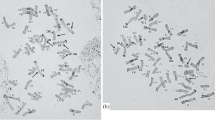Summary
1. Reciprocal crosses were made betweenTriticum vulgare var.graecum Kcke, andT. dicoccum var.Indicum (Khapli Emmer).
2. The germination of the hybrid seeds whenvulgare is used as the female parent is about 33%, whereas when it is used as the male parent the germination is about 3%.
3. All the seedlings from the reciprocal crosses died at very early stages, with the exception of one fromvulgare × Khapli. This seedling was found to be an octoploid with 28 bivalents in the pollen mother cells.
4. The octoploid plant resembled very much the Khapli male parent in respect of the general habit, and the colour of the grains, whereas in the shape of its glumes, ears, and awns it resembled thevulgare parent.
5. The doubling of chromosomes in the amphidiploids may be regarded as a reaction to the effects of external stimuli, representing a new chromosomal balance, which in turn rests upon the mutual adjustment of genes.
Similar content being viewed by others
References
Bhatia, G. S. (1937). “Cytology and genetics of some Indian wheats. I. A new variety of ‘Khapli Emmer’ wheat from India, and its bearing upon the place of origin of Emmer wheats.”J. Genet.35, 321–30.
Bremer, G. (1923). “A cytological investigation of some species and species hybrids within the genusSaccharum.”Genetica,5, 273–326.
Clausen, R. E. &Goodspeed, T. H. (1925). “Interspecific hybridization inNicotiana. II. A tetraploidglutinosa-tabacum hybrid, an experimental verification of Winge’s hypothesis.”Genetics,10, 279–84.
Crowther, J. G. (1934).The Progress of Science. London.
Delaunay, L. H. (1932). “The X-mutations in wheat.”Trud. Lab. Genet., Leningr.,9, 173–80.
Dorsey, E. (1936). “Induced polyploidy in wheat and rye. Chromosome doubling inTriticum, Secale, andTriticum-Secale hybrids produced by temperature changes.”J. Hered.27, 155–60.
Frandsen, H. N. &Winge, O. (1932). “Brassica napocampestris, a new constant amphidiploid species hybrid.”Hereditas, Lund,16, 212–19.
Florell, V. H. (1936). “Chromosome differences in a wheat-rye amphidiploid.”J. agric. Res.52, pp. 199–204.
Goodspeed, T. H. (1929). “The effects of X-rays and radium on species of the genusNicotiana.”J. Hered.20, 243–59.
Hayes, H. K. &Stakman, E. C. (1922). “Wheat stem rust from the standpoint of plant breeding.”Proc. 2nd Ann. Mtg, Canad. Soc. Agron. pp. 997–1012.
Heilborn, O. (1934). “On the origin and preservation of polyploidy.”Hereditas, Lund,19, 233–42.
Howard, A. &Howard, G. L. C. (1910).Wheat in India. Calcutta.
Huskins, C. L. (1928). “On the cytology of speltoid wheats in relation to their origin and genetic behaviour.”J. Genet.20, 103–22.
—— (1931). “The origin ofSpartina Townsendii.”Genetica,12, 531–8.
Hynes, H. J. (1926). “Studies on the reaction to stem rust in a cross between Federation wheat and Khapli Emmers with notes on the fertility of the hybrid types.”Phytopathology,16, 800–27.
Jørgensen, C. A. (1928). “The experimental formation of heteroploid plants in the genusSolanum.”J. Genet.19, 133–211.
Karpechenko, G. D. (1928). “Polyploid hybrids ofRaphanus sativus L. ×Brassica oleracea.”Z. indukt. Abstamm.- u. VererbLehre,48, 1–85.
Kendall, J. (1930). “Histological and cytological studies of stems of plants injected with certain chemicals.” Diss. Sofia Univ.
Kihara, H. &Katayama, Y. (1931). “Zur Entstehungsweise eines neuen konstanten oktoploidenAegilotricum.”Cytologia, Tokyo,2, 234–55.
Kostoff, D. (1930). “A chromosomal chimera in tobacco—somatic non-disjunction and doubling of chromosomes in aNicotiana hybrid.”J. Hered.21, 445–8.
—— (1936). “Studies on the polyploid plants. XI. AmphidiploidTriticum Timopheevi Zhuk. ×Triticum monococcum L.”Z. Zücht. A,21, 41–5.
Levan, A. (1936). “Die Zytologie vonAllium cepa × fistulosum.”Hereditas, Lund,21, 195–214.
Levitsky, G. A. &Benetzkaia, G. K. (1929). “Cytological investigation of constant intermediate rye-wheat hybrids.”Proc. U.S.S.R. Congr. Genet. Pl. and An. Breed. pp. 345–52.
—— —— (1931). “Cytology of wheat-rye amphidiploids.”Bull. Appl. Bot. Genet. Pl. Breed. 27, 241–61.
Longley, A. E. &Sando, W. J. (1930). “Nuclear divisions in the pollen mother cells ofTriticum, Aegilops andSecale and their hybrids.”J. agric. Res.40, 683–719.
Lundegardh, H. (1914). “Zur Mechanik der Kernteilung.”Svensk bot. Tidskr.8, 161–80.
Mol, W. E. de (1923). “Duplication of generative nuclei by means of physiological stimuli and its significance.”Genetica,5, 225–72.
Percival, J. (1936). “Aegilotricum ovata-turgidum. A fertile species hybrid.”Ann. Bot., Lond.,50, 427–36.
Peto, F. H. (1935). “Associations of somatic-chromosomes induced by heat and chloral hydrate treatments.”Canad. J. Res.13, 301–14.
Plotnikova, T. W. (1931). “Einfluss der Röntgenstrahlen auf die Reduktionsteilung von Weizen.”Z. Zücht. A,16, 662–8.
Puttick, G. F. (1921). “The reaction of theF2 generation of a cross between a common and adurum wheat to two biologic forms ofPuccinia graminis.”Phytopathology,11, 205–13.
Randolph, L. F. (1932). “Some effects of high temperature on polyploidy and other variations in Maize.”Proc. nat. Acad. Sci., Wash.,18, 222–9.
Sakamura, T. (1920). “Experimentelle Studien über die Zell-und Kernteilung mit besonderer Rücksicht auf Form, Grösse und Zahl der Chromosome.”J. Coll. Sci. Tokyo,29, 1–209.
Sax, K. (1921). “Sterility in wheat hybrids. I. Sterility relationship and endosperm development.”Genetics,6, 399–416.
—— (1936). “The experimental production of polyploidy.”J. Arnold Arbor. 17, 153–89.
Shimotomai, N. (1927). “Über Störungen der meiotischen Teilungen durch niedrige Temperatur.”Bot. Mag., Tokyo,41, 149–60.
Taylor, J. W. &Leighty, C. E. (1931). “Inheritance in a constant hybrid betweenAegilops ovata andTriticum dicoccum.”J. agric. Res.43, 661–79.
Thompson, W. P. (1930). “Shrivelled endosperm in species crosses in wheat, its cytological cause and genetical effects.”Genetics,15, 99–113.
Thompson, W. P. &Hollingshead, L. (1927). “Preponderance ofdicoccum-like characters and chromosome numbers in hybrids betweenTriticum dicoccum andTriticum vulgare.”J. Genet.17, 283–307.
Tschermak, E. (1929). “Zur zytologischen Auffassung meiner Aegilotriticum bastarde und der Artbastarde überhaupt.”Ber. dtsch. bot. Ges.47, 253–61.
Tschermak, E. &Bleier, H. (1926). “Über fruchtbare Aegilops-Weizenbastarde.”Ber. dtsch. bot. Ges.44, 110–32.
Wakakuwa, Sh. (1934). “Embryological studies on the different seed development in reciprocal interspecific crosses of wheat.”Jap. J. Bot.7, 151–85.
Waterhouse, W. L. (1930). “Australian rust studies. III. Initial results of breeding for rust resistance.”Proc. Linn. Soc. N.S.W. pp. 596–636.
-- (1933). “On the production of fertile hybrids from crosses betweenvulgare and Khapli Emmer wheats.”Proc. Linn. Soc. N.S.W. pp. 99–104.
Watkins, A. E. (1927). “Genetic and cytological studies in wheat. III.”J. Genet.18, 375–96.
Winge, O. (1932). “On the origin of constant species-hybrids.”Svensk bot. Tidskr.26, 107–22.
Additional information
Part III of thesis approved for the Ph.D. degree of the University of London.
Rights and permissions
About this article
Cite this article
Bhatia, G.S. Cytology and genetics of some indian wheats. Journ. of Genetics 35, 331–349 (1938). https://doi.org/10.1007/BF02982359
Issue Date:
DOI: https://doi.org/10.1007/BF02982359



